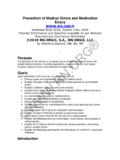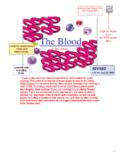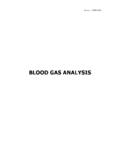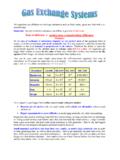Transcription of Blood Gas Analysis - - RN.org®
1 Blood Gas Analysis Reviewed October, 2018, Expires October, 2020 Provider Information and Specifics available on our Website Unauthorized Distribution Prohibited 2018 , , , LLC By Wanda Lockwood, RN, BA, MA Purpose The purpose of this course is to describe Blood gas Analysis , including the types of tests, expected results, sampling, nursing considerations, and acid-base imbalances. Goals Upon completion of this course, one should be able to do the following: Describe normal range of values for at least 6 components of Blood gas Analysis . Explain the relationship of pH to acidosis and alkalosis. Explain how the partial pressure of oxygen (pO2) relates to oxygen bound in hemoglobin. Explain how the partial pressure of carbon dioxide (pCO2) relates to respiratory function and production of carbonic acid.
2 Describe how saturated oxygen (SO2) relates to the oxygen-hemoglobin dissociation curve. Explain the ratio of carbonic acid to bicarbonate (HCO3-). Explain base excess and list a respiratory acid and at least 2 metabolic acids. Describe at least 6 factors that can interfere with arterial Blood gas values. Describe procedures for obtaining arterial, venous, capillary, and cord Blood samples. Explain 3 mechanisms by which the body regulates acid-base balance. Describe 4 primary forms of acid-base imbalance, including causes and symptoms. Introduction Blood gas Analysis is done to determine the acid-base balance in the Blood . The acid-base balance is maintained by the respiratory, cardiovascular, and renal systems. The body, under normal circumstances, is able to maintain a balance between the acids produced as part of metabolism and the bases that are necessary to neutralize and promote excretion of acids.
3 Renal, respiratory and metabolic disorders, such as kidney failure, COPD and diabetes, may lead to acid-base imbalances. Additionally, loss of body fluids through vomiting or diarrhea can lead to acid-base imbalances as well as fluid and electrolyte imbalances. The most commonly used measures for arterial Blood gas (ABG) Analysis include hydrogen ion concentration (pH), partial pressure of oxygen in the Blood (pO2), partial pressure of carbon dioxide in the Blood (pCO2), bicarbonate (HCO3-), oxygen saturation (SO2), and base excess (BE) or (base deficit (BD). pH The hydrogen (H+) ion concentration in the Blood determines whether it is acid or base. The more hydrogen there is, the more acidotic the Blood . Chemical solutions range in pH from 1 to 14 with a neutral pH being 7.)
4 A pH of less than 7 is acidotic and more than 7 is alkalotic. Blood is normally slightly alkalotic. The pH is expressed as a negative logarithm, meaning that the lower the number, the higher the concentration of ions. Thus, a normal pH ranges from to and as that number falls below , the concentration of hydrogen ions increases and the Blood becomes more acidotic. As the pH number increases, the concentration of hydrogen ions decreases, causing the Blood to become more alkalotic. Since the normal Blood is alkalotic, a decrease in pH below results in the condition of acidosis even though the acid-balance may remain slightly alkalotic (above 7 pH). The normal pH is maintained by a ratio of 1 part carbonic acid to 20 parts bicarbonate.
5 Capillary Blood provides an adequate sample for pH measurement. < < > > Death Acidosis Normal pH Alkalosis Death pO2/paO2 PO2 Arterial (paO2) Venous (pvO2) Capillary Cord Blood 8 24 mm Hg 17 41 mm Hg -- Adult/child 80 95 mm Hg 20 49 mm Hg 80 95 mm Hg The partial pressure of oxygen (pO2) in the Blood , usually expressed as partial pressure in arterial Blood (paO2), represents the oxygen dissolved in the plasma. Unless otherwise specified, pO2 and paO2 both are used to represent arterial sampling. Oxygen enters the lungs as a gas, but when the oxygen diffuses into the capillaries at the alveolar level, it changes form and becomes a solution. This oxygen in solution exerts pressure. Some of the oxygen remains as free oxygen in the plasma while some oxygen binds to hemoglobin.
6 The pO2 measures the pressure of only the free oxygen in solution. PO2 is measured in mm Hg and doesn t provide complete information about how much oxygen is in the Blood because it doesn t include the oxygen bound to hemoglobin. Venous Blood has picked up carbon dioxide and lost much of its oxygen so the pvO2 pressure is lower than the paO2 pressure. Capillary Blood can provide adequate information about the partial pressure of oxygen but is usually only used to exclude hypoxia. Venous sampling is not as successful as arterial sampling, so it should not be relied up for accuracy. pCO2/paCO2 PCO2 Arterial (paCO2) Venous (pvCO2) Capillary Cord Blood 32 66 mm Hg 27 49 mm Hg -- Adult/child 35 45 mm Hg 41 51 mm Hg 26 41 mm Hg The partial pressure of carbon dioxide (pCO2 or paCO2) is important for the evaluation of ventilation as this level is controlled primarily by the lungs.
7 The paCO2 is usually evaluated after the pH to determine if respiratory function is adequate. Capillary Blood provides an adequate sample for pCO2 testing. <35 mm Hg 35 -45 mm Hg >45 mm Hg Increases pH and increases alkalinity. Normal Decreases pH and increases acidity Carbon dioxide forms carbonic acid when it dissolves in Blood . Note that a 10 mm Hg increase in paCO2 associated with acute respiratory acidosis lowers the pH about while with chronic respiratory acidosis the pH lowers only Conversely, a 10 mm Hg decrease in paCO2 associated with acute respiratory alkalosis increases the pH about while chronic respiratory alkalosis increases the pH only about Drugs that increase pO2 Theophylline. Urokinase. Drugs that decrease pO2 Althesin.
8 Barbiturates. Granulocyte-macrophage colony-stimulating factor. Meperidine. Isoproterenol. Drugs that increase pCO2 Acetylsalicylic acid. Aldosterone bicarbonate. Carbenicillin, Corticosteroids. Oxygen saturation (sO2/saO2) SO2 Arterial (SaO2) Venous (SvO2) Capillary Cord Blood 40 90% 40 70% -- Adult/child 95 99% 70 75% 95 98% Each molecule of hemoglobin contains four iron-containing heme sites to which oxygen can bind. As some of the free oxygen in solution binds to the heme, the hemoglobin becomes saturated with oxygen. Wikimedia Commons, CC The saO2 level is calculated as a percentage of the total heme sites saturated with oxygen. So, if there are 100 available heme sites and 97 have bound to oxygen, then the saO2 level would be 97%.
9 While the saO2 level gives information about the effectiveness of the hemoglobin in binding to oxygen, it doesn t provide adequate information about the total amount of oxygen, because this is dependent on the hemoglobin count. If hemoglobin is very low, even a saturation of 100% may not provide adequate oxygenation to the tissues. The oxygen saturation level is influenced by the paO2 level because if the paO2 level Dexamethasone. Ethacrynic acid. Laxatives (used chronically). X-ray contrast agents. Carbenoxolone. Drugs that decrease pCO2 Acetazolamide. Acetylsalicylic acid. Ethamivan, Neuromuscular relaxants (2ndry to post-operative hyperventilation). NSD 3004. Theophylline. Tromethamine. Xylitol. falls significantly, there is not enough oxygen in solution to bind to available heme.
10 SO2 is based on 100% normal hemoglobin A. Hemoglobin can bind 1. 37 mL per gram of hemoglobin, markedly increasing the content of oxygen in the Blood . If hemoglobin S (sickle cell) is present, then there will be decreased oxygen binding, causing a shift in the right of the oxygen dissociation curve (lower saturation per given pO2). Both fetal hemoglobin and methemoglobin can cause a shift to the left (higher saturation per given pO2) with increased oxygen binding. The oxygen-hemoglobin dissociation curve shows the relationship between sO2 and pO2. At 80 - 90 pO2, hemoglobin is fully saturated so increased pO2 won t further increase saturation. The critical point for pO2 is 60 because below this point, there is a marked decrease in saturation, as demonstrated by the curve.















